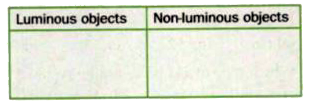We can see a non-luminous object when light:
A
emitted by the object falls on the eye.
B
is reflected from the object towards our eye.
C
completely passes through the object.
D
gets completely absorbed by the object.
Video Solution
Text Solution
The correct Answer is:B
B
|
Topper's Solved these Questions
- LIGHTBOOK - NCERT EXEMPLARCHAPTER - LIGHTEXERCISE - VERY SHORT ANSWER QUESTIONS
5 Videos
- LIGHTBOOK - NCERT EXEMPLARCHAPTER - LIGHTEXERCISE - SHORT ANSWER QUESTIONS
6 Videos
- FRICTIONBOOK - NCERT EXEMPLARCHAPTER - FRICTIONEXERCISE - LONG ANSWER QUESTIONS
3 Videos
- SOME NATURAL PHENOMENABOOK - NCERT EXEMPLARCHAPTER - SOME NATURAL PHENOMENAEXERCISE - LONG ANSWER QUESTIONS
5 Videos
Similar Questions
Knowledge Check
Which of the following objects is a non-luminous object?
AObiect that produce lightBObject that absorb lightCObject that do not produce lightDObject that reflect lightWhich of the following objects is a non-luminous object?
ABulbBSpoonCCandleDTorchWhich of the following is a non-luminous object?
ASunBStarsCEarthDFirefly
Moon is a luminous object.
View SolutionMoon is a non-luminous object. Explain why?
View SolutionFill the boxes given below with examples of any five luminous and non-luminous objects each.

View SolutionDo you think it is possible for us to see non-luminous objects present around us?
View SolutionWhich of the following is a non-luminous body?
View Solution
